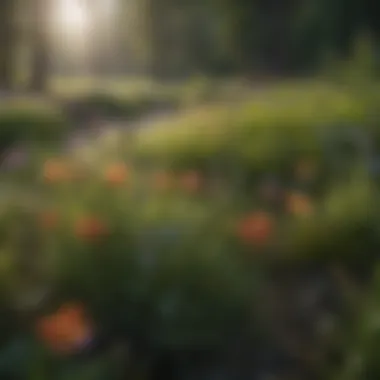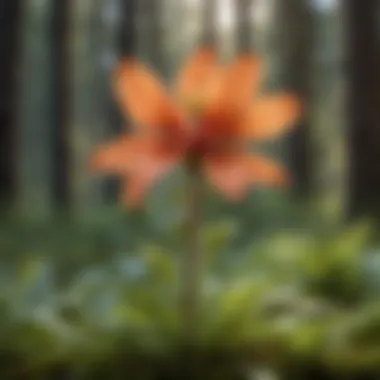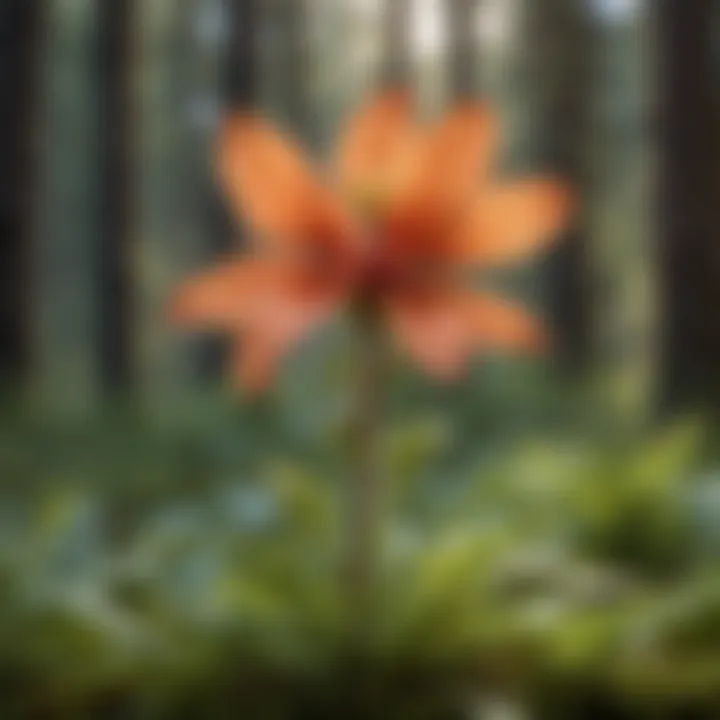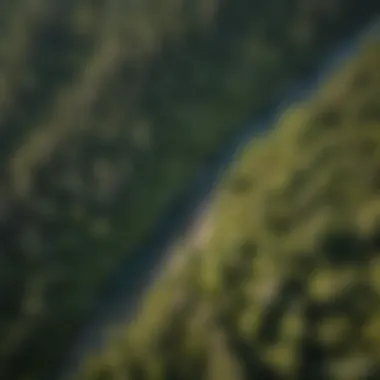Elk River Flowers: Exploring Flora and Conservation


Intro
The Elk River region is a vibrant landscape teeming with a variety of flora that plays a crucial role in maintaining the health of local ecosystems. This region is characterized by diverse species of flowers, both native and non-native, that contribute to the ecological balance and cultural richness of the area. Understanding this flora not only enhances our appreciation of nature but also facilitates effective conservation strategies and sustainable practices.
This exploration aims to shed light on the intricate relationships between the varied plant species in Elk River, their contributions to biodiversity, and their significance in conservation efforts. A comprehensive examination will delve into the importance of each flower species and their interactions with other elements of the ecosystem. Through this narrative, readers will uncover how plants influence the environment and local communities.
The following sections will provide a detailed overview of woodland ecosystems, sustainable forestry practices, and woodland stewardship techniques. This information is geared towards forestry professionals and academics seeking to deepen their knowledge of the Elk River's unique floral landscape.
Prolusion to Elk River Flora
Understanding the flora of the Elk River region is essential for both ecological balance and cultural identity. Flowers are not mere aesthetic components; they play critical roles in the ecosystem. By examining the variety of flowering plants in this area, we can better appreciate their contributions to biodiversity, soil health, and even cultural practices in local communities.
Geographical Context of Elk River
The Elk River region is characterized by its unique geography, which influences its floral diversity. Nestled among mountains and valleys, the area boasts varied microclimates. This variability dictates which species can flourish. For instance, the presence of both elevation and water sources provides habitats suitable for a range of flowering plants, from lowland marshes to rocky mountain slopes.
The Elk River's surrounding landscapes, including forests and meadows, create a rich tapestry for various plant life to thrive. Factors such as soil composition and rainfall patterns also play a vital role. Various ecosystems within the region include wetlands, riparian zones, and dry uplands, each supporting distinct flora.
Conservation planners and ecologists must be attentive to these geographical nuances. Such understanding enhances efforts to maintain ecological balance.
Significance of Flowering Plants
Flowering plants are indispensable for maintaining the ecological integrity of the Elk River region. They serve as primary producers, generating oxygen and forming the base of the food web. The presence of diverse flower species supports pollinators like bees and butterflies, which are critical for fruit and seed production.
Furthermore, flowering plants contribute to soil conservation by preventing erosion. Their root systems stabilize the ground, making it resistant to washouts during heavy rain. Beyond ecology, these plants possess medicinal and agricultural significance. Locals often foraged for specific plants, utilizing them in traditional remedies or integrating them into culinary practices.
"The floral diversity in Elk River is not just a natural phenomenon but a cultural asset that weaves into the very fabric of life in the region."
The importance of flowers extends to their aesthetic value as well. The seasonal blooms attract tourists and nature enthusiasts, fostering a strong connection to the environment. Thus, understanding the role of these plants—ecologically, economically, and culturally—is vital for preservation and planning efforts in Elk River.
Ecosystem Overview
The ecosystem of the Elk River region plays a crucial role in the sustainability and health of its floral diversity. This area is home to numerous flowering plants, each contributing uniquely to the local environment. Understanding the interactions between various species helps in recognizing their significance within the ecosystem.
Floral Diversity in Elk River
Floral diversity in Elk River can be described as a mosaic of habitats. This rich palette includes wetlands, grasslands, and forests. Each habitat hosts distinct species of flowers that adapt to their surroundings, from the vibrant hues of wildflowers in meadows to the delicate blooms of shaded forest understories.
Some common native flowers include specialties like the Oregon grape and wild geranium, which not only add aesthetic value but also provide food sources for pollinators. The presence of diverse species enhances ecosystem resilience, making it vital for ongoing ecological health.
The abundance of floral species can be observed as an indicator of a thriving ecosystem. Various studies indicate that higher floral diversity correlates with increased species richness among insects, birds, and other wildlife. Building on this understanding allows for improved conservation strategies to protect both common and rare plant species.
Roles of Flowers in Ecosystem Health
Flowers do more than beautify the landscape; they serve essential functions within the ecosystem. One primary role is supporting biodiversity. Many flowers are key sources of nectar and pollen for pollinators, such as bees, butterflies, and hummingbirds. These interactions are critical for plant reproduction. Without pollinators, many flowering species would struggle to produce seeds.
In addition to pollination, flowers contribute to soil health. Decomposing flowers add organic matter that enriches soil structure, promoting nutrient cycling. Furthermore, some flowering plants, like legumes, can fix nitrogen in the soil, enhancing fertility and supporting other plant species.


- Food Supply: Flowers like clover provide food for herbivores, indirectly supporting higher trophic levels.
- Habitat Creation: Dense flowering vegetation can provide shelter for small mammals and insects.
- Erosion Control: The root systems of flowering plants help stabilize soil, reducing erosion in riparian zones.
In summary, the health and stability of the Elk River ecosystem are intricately linked to its floral diversity. Protecting and preserving these flowering species is vital for maintaining ecosystem balance and promoting overall environmental resilience.
"Biodiversity does not just represent a variety of life; it is the foundation for ecosystem services that sustain life on Earth."
Understanding these dynamics helps guide conservation efforts and policy decisions, ensuring that the Elk River region continues to thrive.
Native Flower Species
The exploration of native flower species within the Elk River region reveals critical connections to local ecology and biodiversity. Native plants are those that evolve in a specific region over thousands of years. They are well adapted to the local soils, climate, and wildlife, making them vital to the overall health and stability of the ecosystem. Understanding native species is essential for effective conservation efforts and habitat restoration.
Common Native Flowers
Several common native flowers populate the Elk River area, each contributing uniquely to the ecosystem. Some notable species include:
- Wild Lupine (Lupinus perennis): This plant has striking blue flowers and is essential for supporting the life cycle of various butterflies.
- Black-eyed Susan (Rudbeckia hirta): Featuring bright yellow petals with a dark center, this flower adds vibrant color and provides nectar for pollinators.
- Purple Coneflower (Echinacea purpurea): Known for its medicinal properties, this species also attracts bees and butterflies, playing a key role in local pollinator populations.
These flowers not only beautify the landscape but also create habitats and food sources for various insects and wildlife.
Ecological Importance of Native Species
The ecological role of native species cannot be overstated. They forge essential relationships within the ecosystem that enhance biodiversity and resilience. Native flowers help maintain soil quality, prevent erosion, and provide food and shelter for insects, birds, and other wildlife. This symbiotic relationship fosters a balanced environment that supports both plant and animal life.
"Preserving native flora is not just important for aesthetics; it is crucial for ecological balance."
Additionally, native plants often require less water and fewer chemical inputs, promoting sustainable land use practices. When non-native species invade, they can disrupt these relationships and lead to decreased biodiversity.
As we consider conservation and restoration strategies, focusing on native species is a logical approach. Understanding the complex interplay between these plants and their environment enables better decision-making in forestry and land management practices. Enhancing native flora should be prioritized for a healthier, more resilient ecosystem in the Elk River region.
Non-Native Flower Species
Non-native flower species play a complex role in the Elk River region. Understanding these species is vital for grasping the dynamics of local ecosystems. Non-native species refer to plants that have been introduced to an area where they do not naturally occur. Their introduction can stem from various sources, including horticultural practices, accidental release, or agricultural activities. Although these species can enhance floral diversity, they also raise important considerations for local ecosystems and native flora.
Preamble of Non-Native Species
Non-native flower species have been introduced to the Elk River area for several reasons. They can be appreciated for their aesthetic value, longer blooming periods, and adaptive traits that enhance garden variety. For instance, the Japanese honeysuckle has become popular due to its fragrant flowers and rapid growth. Similarly, Phlox paniculata, or garden phlox, brings bright colors and is favored by gardeners.
The introduction of such species may provide benefits in terms of visual appeal and potential support for pollinators. However, it is essential to evaluate the consequences these plants pose to the existing ecosystem. In many cases, non-native flowers can outcompete local species, thus disrupting the established balance in the ecological community.
Impact on Local Ecosystem
The presence of non-native flower species can have significant impacts on the local ecosystem. One of the primary concerns is their ability to displace native plants. This competition can result in a decrease in biodiversity. Native species often evolved to fill specific ecological niches within their environment. When non-native plants invade, they may grow faster, spread more easily, and take resources away from local flora. This can lead to a decline in native plant populations, which are crucial for sustaining local wildlife.
"The competitive nature of non-native species can transform local habitats, altering the interactions between plants and the wildlife that depend on them."
In addition, some non-native species may disrupt pollinator relationships. Native insects, such as bees and butterflies, rely on specific plants for their life cycles. When non-native flowers replace these plants, it can create a gap in the food web. This shift can lead to a decline in pollinator populations, which in turn affects broader ecosystem health.


In summary, while non-native flower species can bring certain benefits to gardens and landscaping, they must be managed carefully. Their potential to disrupt local ecosystems serves as a reminder of the delicate balance within these environments. Understanding their role provides essential insights for conservation efforts and ecological management in the Elk River region.
Conservation Efforts
Conservation of flora in the Elk River region is vital for maintaining not only the unique biodiversity of the area but also for ensuring the health of the entire ecosystem. The flowers native to this region play essential roles in supporting various wildlife species. Moreover, they contribute significantly to local cultural practices and the economy. Therefore, it is imperative that concerted efforts are placed on conservation to protect these resources.
Importance of Conservation in Elk River
The importance of conservation in the Elk River cannot be overstated. The region is home to a variety of plant species, many of which are endemic and provide necessary habitats for wildlife. When we prioritize conservation, we ensure the survival of these plants and, by extension, the creatures that rely on them.
Key benefits include:
- Biodiversity Preservation: Flora diversity allows for a stable ecosystem, where species interaction supports a balanced environment.
- Climate Regulation: Plants play a crucial role in carbon sequestration, which aids in combating climate change.
- Cultural Heritage: Many local traditions are tied to specific plants, which means their loss may lead to a decline in cultural practices.
- Scientific Research: Protecting these species opens doors for research opportunities that may lead to discoveries in ecology and medicine.
Local Initiatives and Organizations
Various organizations and community initiatives are actively engaged in conservation efforts within the Elk River region. These fronts are critical as they mobilize resources and raise awareness about the importance of flora conservation. A few notable efforts include:
- Elk River Conservation Group: This organization focuses on habitat restoration and the protection of native plant species. They engage in community education programs and frequently hold volunteer events to enhance local habitats.
- Wildflower Society: They promote awareness of native flowers and lead campaigns to encourage local gardeners to use native plants in landscaping. This effort not only beautifies spaces but supports local wildlife.
- Local Schools: Many educational institutions are integrating environmental studies into their curriculums to teach young minds about the significance of native flora and conservation principles. This initiative aims to inspire the next generation of conservationists.
“Conservation is a state of harmony between men and land.”
– Aldo Leopold
Overall, conservation efforts are essential. They ensure that the unique flora of the Elk River region can be enjoyed by future generations while supporting local ecosystems and communities.
Cultural Significance of Flowers
In the context of Elk River, the cultural significance of flowers extends beyond their aesthetic appeal. Within many local traditions, flowers symbolize not just beauty but also convey deep meanings and values. The relationships between the many plant species and the local populace illustrate a rich tapestry of cultural heritage that intertwines with ecological awareness, history, and identity. Understanding these cultural associations can enhance appreciation for the diverse floral landscape.
Flowers in Local Traditions
Flowers play an essential role in various local traditions among the communities surrounding Elk River. They are often featured in celebrations, rituals, and community gatherings. For example, certain flowers may be specifically used in seasonal festivals or local events, marking significant times in the year such as spring equinox or harvest time.
Additionally, flowers are a part of storytelling and lore. Different species are tied to folklore narratives that speak to the relationship between the natural world and human experience. This connection emphasizes respect and stewardship for the environment.
- Symbolism: Flowers like the Indian Paintbrush and Wild Rose hold specific meanings within local cultures. Each species tells a story that enriches the community’s cultural heritage.
- Ceremonial Use: Flowers are often incorporated into weddings and memorial services, serving as a medium of expression for love, remembrance, and commitment.
The incorporation of flowers into everyday life emphasizes their importance and the connection between the community and its environment. This connection contributes to a sense of identity among residents and nurtures a communal appreciation of their natural surroundings.
Economic Value of Floral Products
In addition to cultural importance, flowers also possess significant economic value in the Elk River region. The local economy benefits from both the cultivation and commercialization of various floral products.
- Horticulture and Floriculture: Many local businesses specialize in the growth and sale of native flowers. This industry creates jobs and supports the local economy by attracting visitors, particularly during peak bloom seasons. The unique native flora of the region is increasingly sought after for landscaping, conservation, and ecological restoration projects.
- Floral Art: Artisan floral arrangements made from locally sourced flowers have gained popularity. These products are often available at local markets or through small businesses, promoting the use of native species while also providing economic incentives for growers.
The economic impact of the floral industry is notable. By fostering industries centered on regional flora, the Elk River area can promote sustainable practices that benefit both the economy and the environment.
"The cultivation and appreciation of local flora not only support economic growth but also emphasize the intrinsic value of the ecosystem intertwined with local lifestyles."


In summary, flowers are deeply woven into the cultural and economic fabric of Elk River’s community. Their presence shapes not only local traditions but also sustains economic activities that respect and enhance the ecological landscape.
Educational Implications
Understanding the flora of the Elk River region extends far beyond mere appreciation of its beauty. It plays a crucial role in the educational framework for both students and the greater community. Fostering knowledge about local plants cultivates an awareness of ecological interdependence, which is fundamental for preserving biodiversity. In addition, integrating floral studies into educational curricula encourages research, understanding, and respect for the natural environment. It also equips the younger generation with the skills necessary to engage meaningfully in conservation efforts.
Teaching About Flora in Schools
Incorporating the study of native and non-native flowers within school programs offers students a chance to explore their local ecosystem. This hands-on approach can include projects that involve identifying local plant species, discussing their roles within their environments, and understanding their uses in traditional practices. By understanding the adaptability, roles, and relationships of these plants, students can also grasp broader concepts such as climate change, habitat loss, and sustainability.
Schools can create partnerships with local conservation groups, leading to field trips where students can observe and study plants in their natural settings. Research and data collection can also be integrated through citizen science projects, where students contribute to ongoing studies on floral diversity and health.
Community Engagement in Floriculture
Community involvement is fundamental in promoting interest in floriculture. Local workshops can offer members hands-on experiences by teaching them about plant care and the ecological importance of local flora. Such initiatives can help address the decline in native plant populations and invasive species management.
Furthermore, engaging residents in beautification projects enhances public spaces with native plants, which support local biodiversity while improving the quality of life for community members. Encouraging community gardens promotes sustainable practices and provides opportunities for individuals to connect with nature.
Educational programs that focus on local flora can lead to a more informed and engaged populace, resulting in stronger support for conservation initiatives. The combined effort of schools and communities can create a robust framework for understanding the essential role that Flora plays in the Elk River region.
Educating about flora is not just about plants; it is about cultivating a sense of stewardship and responsibility toward our environment.
Future Directions
The exploration of flora in the Elk River region reveals a rich tapestry of plants and ecosystems. As conservation needs become more pressing, understanding the future directions of floral research and conservation is essential. This section discusses the innovations in floral conservation and the opportunities available for further research in the Elk River.
Innovations in Floral Conservation
Recent advancements in conservation techniques are increasingly important for protecting the diverse flora of the Elk River region. Innovative practices include the use of modern technology in monitoring ecosystems, such as drone surveys and geographic information systems (GIS). These tools allow conservationists to collect data on plant health and biodiversity efficiently.
Another promising approach is the application of genetic analysis in plant conservation. Understanding genetic diversity among native species helps identify populations that are at risk and informs breeding programs aimed at restoring lost flora. Additionally, community involvement in conservation through citizen science initiatives has gained popularity. This model fosters local engagement and empowers individuals to participate actively in monitoring and preserving their environment.
The integration of traditional ecological knowledge with scientific methods also shows potential. Collaborating with local indigenous communities can uncover historical relationships with the land that may contribute to more sustainable management practices.
"Innovations in floral conservation require a comprehensive approach that blends technology, community engagement, and traditional knowledge."
Research Opportunities in Elk River Flora
The Elk River region presents numerous research opportunities for those interested in floral studies and conservation. Identifying key research areas can lead to informed practices that benefit local ecosystems. Topics such as the impact of climate change on flowering patterns and species distribution are crucial, given the shifting environmental conditions. Conducting studies to assess how these changes affect native plant populations can guide future conservation strategies.
Furthermore, research on the interactions between flowering plants and pollinators can provide insights into ecosystem health. Understanding these relationships is key to maintaining biodiversity and ensuring the health of local habitats.
An interdisciplinary approach that involves collaboration among botanists, ecologists, and social scientists can enrich understanding of the intricate systems at play in the Elk River region. Grant funding and partnerships with academic institutions are vital for supporting these research initiatives.
In summary, focusing on innovative conservation techniques and actively pursuing research opportunities will contribute significantly to preserving the flora of the Elk River. As the ecosystems face numerous threats, the direction taken by future research and conservation efforts will not only benefit the flora but also the broader health of the region.
Epilogue
The exploration of the flora in the Elk River region culminates in an understanding of how these flowering plants are not just decorative elements but crucial components of the ecosystem. This article has leaned into the multifaceted role of flowers, elaborating on their ecological significance, the threats they face, and the efforts being made to protect them. Acknowledging these factors is essential for fostering a deeper appreciation of the natural world.
Summation of Key Points
- Floral Diversity: The Elk River's unique geographical and climatic conditions foster a wide array of native flowers, which play a significant role in maintaining biodiversity.
- Ecological Importance: Flowers are pivotal in pollination processes, supporting various wildlife species and ensuring the productivity of local ecosystems.
- Cultural Relevance: Local communities have long valued these plants for their aesthetic and economic contributions, intertwining flowers into cultural narratives and practices.
- Conservation Challenges: Non-native species pose a threat to native floral populations, highlighting the need for concerted conservation efforts.
- Future Research: Continued research and innovation in floral conservation will be necessary to adapt to changing environments.
Call to Action for Conservation
The responsibility for preserving the vibrant floral life of the Elk River region lies with both individuals and organizations. It is imperative that local community members engage in conservation initiatives designed to protect these unique plants. Steps can include supporting local environmental groups, participating in clean-up efforts, and advocating for responsible land use policies.
Moreover, education is key. Informing the next generation about the importance of flora preservation can stimulate a culture of respect toward nature. Instructors can utilize the variety of species as a teaching tool, thereby fostering stewardship of this ecological treasure.







